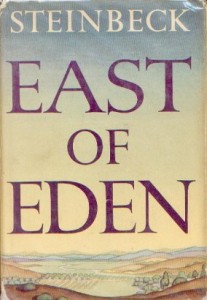 East of Eden first seduced me as a young girl, its Viking book jacket beckoning from my grandmother’s extensive library of novels. The cover—a blue-blond sky that gives way to undulant, sparse brown hills and a smattering of trees—was not unlike the hilltop view from my childhood home. I descend from a pioneer Western family, whose legacy of thriving in one of America’s harshest landscapes was even then shaping me. I dreamed of escaping from that tiny town in the Nevada desert, and my only source of cultivation was on those bookshelves.
East of Eden first seduced me as a young girl, its Viking book jacket beckoning from my grandmother’s extensive library of novels. The cover—a blue-blond sky that gives way to undulant, sparse brown hills and a smattering of trees—was not unlike the hilltop view from my childhood home. I descend from a pioneer Western family, whose legacy of thriving in one of America’s harshest landscapes was even then shaping me. I dreamed of escaping from that tiny town in the Nevada desert, and my only source of cultivation was on those bookshelves.
Reading East of Eden as a girl, and then again in high school, I found a romantic story of love and passion, a portrait of a woman as strong as any man in her world. That simplistic and one-dimensional interpretation alone was enough to rivet me. But when I read the book as an undergraduate English major, I discovered layers of literary elegance in the novel’s modern retelling of the stories of Adam and Eve, Cain and Abel, and in its exploration of the nature of good and evil.
But more recently, reading East of Eden as an adult, journalist, and author, has led me to my writer’s sense of place. A newspaper reporter, war correspondent, Nobel Laureate, and native son of the American West who was prolific across genres, Steinbeck showed the value of the arid West as a literary setting. Writers may have an eye for observation, but not until they recognize a place as worthy of their attention do they begin to observe. Steinbeck’s multigenerational epic, sprawling across forbidding lands, inspired at least three of my books: American Massacre, Passion and Principle, and Faith and Betrayal.


